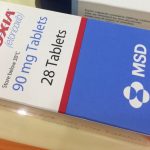Lorstan: Uses, Dosage, Side Effects, Interaction

Lorstan is a brand of losartan potassium, a prescription medication that belongs to a group of drugs called angiotensin II receptor antagonists. It keeps blood vessels from narrowing, which lowers blood pressure and improves blood flow.
Lorstan is used to treat high blood pressure (hypertension). It is also used to lower the risk of stroke in certain people with heart disease. Lorstan is used to slow long-term kidney damage in people with type 2 diabetes who also have high blood pressure.
How Lorstan works
Lorstan works by blocking the action of angiotensin II, a chemical in your body that causes your blood vessels to tighten and narrow. Losartan helps relax and widen your blood vessels. This lowers your blood pressure.
This action helps treat high blood pressure as well as the other two conditions. Losartan is usually prescribed for high blood pressure and left ventricular hypertrophy (LVH) increases your risk of stroke, so lower blood pressure reduces your risk.
Lower blood pressure also reduces your risk of kidney damage. This is because high blood pressure raises your risk of kidney damage that’s caused by the high blood sugar levels linked with diabetes.
How should this medicine be used?
Lorstan comes as a tablet to take by mouth. It is usually taken once or twice a day with or without food. To help you remember to take Lorstan, take it at around the same time(s) every day. Follow the directions on your prescription label carefully, and ask your doctor or pharmacist to explain any part you do not understand. Take Lorstan exactly as directed. Do not take more or less of it or take it more often than prescribed by your doctor.
- For oral dosage form (tablets):
- For high blood pressure:
- Adults—At first, 50 milligrams (mg) once a day. Your doctor may adjust your dose as needed.
- Children 6 to 16 years of age—Dose is based on body weight and must be determined by your doctor. The starting dose is usually 0.7 milligram (mg) per kilogram (kg) of body weight per day. Your doctor may adjust your dose as needed. However, the dose is usually not more than 50 mg per day.
- Children younger than 6 years of age—Use and dose must be determined by your doctor.
- For lowering the risk of stroke in patients with high blood pressure and enlargement of the heart:
- Adults—At first, 50 milligrams (mg) once a day. Your doctor may adjust your dose and add another medicine based on your blood pressure response.
- Children—Use and dose must be determined by your doctor.
- For diabetic nephropathy:
- Adults—At first, 50 milligrams (mg) once a day. Your doctor may adjust your dose based on your blood pressure response.
- Children—Use and dose must be determined by your doctor.
- For high blood pressure:
Your doctor will probably start you on a low dose of Lorstan and gradually increase your dose.
If your child can not swallow a tablet, talk to your doctor or pharmacist. The pharmacist can prepare a liquid form of this medication for your child.
Lorstan controls high blood pressure but does not cure it. Your blood pressure may decrease during the first week of your treatment, but it may take 3 to 6 weeks for you to notice the full benefit of Lorstan. Continue to take Lorstan even if you feel well. Do not stop taking Lorstan without talking to your doctor.
Ask your pharmacist or doctor for a copy of the manufacturer’s information for the patient. Also, talk to your doctor about the possible risks of using this medication for your condition.
What are the side effects of Lorstan?
Common side effects of Lorstan include:
• cold or flu symptoms such as stuffy nose, sneezing, sore throat, fever, and cough
• diarrhea
• dizziness
• headache
• leg or back pain
• muscle cramps
• sleep problems (insomnia)
• stomach pain
• tiredness, and
Tell your doctor if you experience serious side effects of Lorstan including pain or burning when you urinate; pale skin, lightheadedness, shortness of breath, rapid heart rate, trouble concentrating; wheezing, chest pain; drowsiness, confusion, mood changes, increased thirst, loss of appetite, nausea and vomiting; swelling, weight gain, urinating less than usual or not at all; or high potassium (slow heart rate, weak pulse, muscle weakness, tingly feeling).
Interactions
Tell your doctor about all medicines you use, and those you start or stop using during your treatment with Lorstan, especially:
• a diuretic or “water pill”;
• other blood pressure medications;
• lithium;
• celecoxib; or
• aspirin or other NSAIDs (non-steroidal anti-inflammatory drugs) such as ibuprofen (Advil, Motrin), naproxen (Aleve), celecoxib, diclofenac, indomethacin, meloxicam, and others.
This list is not complete. Other drugs may interact with Lorstan, including prescription and over-the-counter medicines, vitamins, and herbal products. Not all possible interactions are listed in this medication guide.





